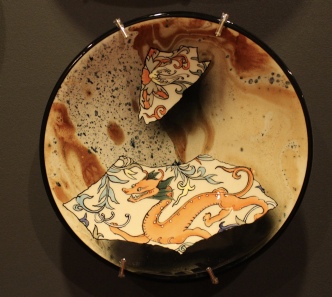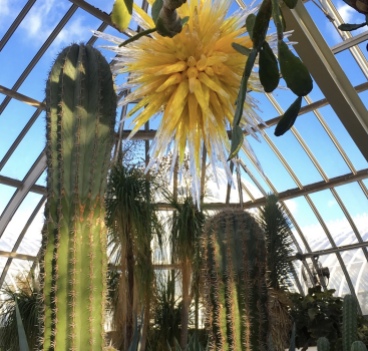At the University of Pittsburgh’s interdenominational neo-Gothic Heinz Memorial Chapel, a chic lady with an ash blonde asymmetrical bob told us that the founder of the H.J. Heinz Co., Henry John Heinz, built the chapel to honor his mother, Anna Margaretta Heinz. In 1938, Howard Heinz, H.J.’s son, dedicated the chapel “to culture, an understanding response to beauty, and religious worship.” All 23 of the stained glass windows were designed by Pennsylvania native Charles J. Connick. The five chancel windows at the front represent the virtues of Justice, Faith, Charity, Hope and Wisdom. The 73-foot-tall transept windows, among the tallest in the world, represent Temperance, Truth, Tolerance, and Courage. Equal numbers of men and women from the Middle Ages to the late 19th century are depicted, including such illustrious folks as William Penn, Lewis and Clark, Pocahontas, Abraham Lincoln, St. Joan of Arc, Florence Nightingale, Emily Dickinson, and George Washington.
As I looked in awe at the gorgeous chapel, I told the curator that this chapel is certainly bigger and fancier than the humble Wren Chapel, where I got married for the first time, at the College of William and Mary. The Heinz Chapel is used similarly today: for weddings, religious services, concerts, classes, memorial services and guided tours. The chapel provides an overlapping point between history and everyday life, brought about by the love of a very wealthy son for his mother, and providing a venue today for love, education and spiritual nourishment.

Heinz Memorial Chapel
The 42-story Late Gothic Revival Cathedral of Learning sits across a wide green lawn from the Heinz Chapel. The building, affectionately called “Cathy” by students, was overheated and uncomfortable, so we stripped off our coats and lugged them around. Built in 1926, it is the tallest educational building in the Western hemisphere and the second tallest university building in the world.

Cathedral of Learning
The 30 Nationality Rooms, donated by the national and ethnic groups that helped build the city of Pittsburgh, are the most intriguing part of the building. These classrooms are used by University of Pittsburgh students, and though they are open to tourists, we were instructed to make sure the rooms weren’t occupied by students before barging in. I love how this building is used today by students and equipped with chalkboards, erasers, desks designed in ethnic patterns, and flat screen TVs. As it was a school day, some of the rooms were in use, but we were able to drop into to several of them: the Czechoslovak, German, Russian, Norwegian, French, Yugoslav, Scottish, and Romanian Rooms. My favorites were the African Heritage, the Indian and the Syria-Lebanon Room.
Under the grand Indiana limestone arches in the center of the Cathedral of Learning, students sat at tables absorbed in study. Here the overlap between history and everyday life was evident. Students were using, for their modern-day education, an early 20th century church-like building not only honoring the ethnic makeup of their city, but previous generations as well.

Center aisle of Cathedral of Learning
I entreated Mike to drive by Shadyside Presbyterian Church, where Annie Dillard attended church as a child of privilege. She grew to hate sitting in church, especially as her parents didn’t attend, and when she wrote a “fierce letter” to the minister to quit the church, her father and mother, at wit’s end, didn’t know what to do with her. Her father said to her: “But didn’t I see? That people did these things – quietly? Just – quietly? No fuss? No flamboyant gestures. No uncalled-for letters.” In the end, her father was “forced to conclude that I was deliberately setting out to humiliate Mother and him.” I loved Dillard’s feisty nature and her love of life.

Shadyside Presbyterian Church
The Frick Pittsburgh, a classy place with curvaceous draperies and cranberry damask wallpaper, showcased a wonderful ceramics show called Revive, Remix and Respond. In the exhibit, artists “breathe[d] new life” into ceramics in a way that responded to the Frick’s Pittsburgh collection. I love ceramics as an echo of textile design. I especially loved the peacock flashing its tail of broken ceramic plates. Old discarded porcelain in beautiful patterns was refashioned into a colorful creature. I also loved the plates “quilting together” Asian patterns into a whole. I love Asian textiles and used to buy them back in the day when I designed and made quilts, so I found these porcelain “quilts”enchanting.

- Peacock I (2016) by Bouke de Vries
The collection of triptychs also captured my attention, as I grew up Catholic and worshiped in the Episcopal Church as an adult. I have always been drawn to religious icons. Although I no longer attend church, I have a small collection of icons at home.

triptych

triptych
It was industrialist and art patron Henry Clay Frick who created this museum, as well as the amazing Frick Collection in New York. His involvement with the coke and steel industry allowed him to create art galleries that people will be able to enjoy for generations, leaving a legacy that informs our everyday lives today.

Clayton, Henry Frick’s house
Finally, we ended up at the Phipps Conservatory & Botanical Gardens, where I have never seen such a huge and sprawling conservatory. As it was frigid outside, we stayed inside the entire time, with no shortage of themed rooms to explore. We found Dale Chihuly glass sculptures, orchids, bonsai, palms, a desert environment, a pond and treasure island and fountain of youth. We also discovered a chocolate tree native to Amazonia, in which each pod contains 20-60 bitter almond-sized “beans” in white pulp.

another Chihuly
Most exciting was a Cuba exhibit that immersed us in the rain forest of that country. The display included cultural items such as a bright-blue vintage car, ornamental paddle fans adorned with hand-painted fronds, maracas made of hollowed-out gourds, and a Farmacia.
Henry W. Phipps, steel and real estate magnate, donated the conservatory to the City of Pittsburgh in 1893, and thus has brought pleasure and botanical education to generations of people over 125 years.
During dinner at Village Tavern and Trattoria in our scruffy Southside neighborhood, we told our waitress in all-black that we were staying at an Airbnb nearby. She was surprised: “I know about that Airbnb; it’s not much to look at from outside but a friend of mine stayed there and once and he invited me in to see it. It’s nice inside!”
She then told us the street in front of the restaurant was closed off because there was a landslide on a nearby hill earlier in the week, and a woman’s house went down with it. She had just finished paying off her mortgage and insurance didn’t cover it because it was “an act of God.” Luckily, people in the community have already raised $40,000 through GoFundMe.
After dinner, we drove to Grandview Avenue where we had sweeping views of Pittsburgh at night.

Nighttime Pittsburgh from Grandview Avenue
************************
“PROSE” INVITATION: I invite you to write a 700 to 1,000-word post on your own blog about a recently visited particular destination (not journeys in general). Concentrate on any intention you set for your prose. In this case, I tried to meet some of my intentions: discovering the overlap between history and everyday life, finding the essence of a place, and telling what is surprising about a location. (I don’t recommend setting this many intentions. For my next journey, I hope to simplify.)
You can either set your own writing intentions, or use one of the prompts I’ve listed on this page: writing prompts: prose & poetry. (This page is a work in process.) You can also include photos, of course.
Include the link in the comments below by Monday, May 14 at 1:00 p.m. EST. When I write my post in response to this challenge on Tuesday, May 15, I’ll include your links in that post. My next post will be about our second day in Pittsburgh, and, again, I’ll be using the same intentions. 🙂
This will be an ongoing invitation. Feel free to jump in at any time. 🙂
I hope you’ll join in our community. I look forward to reading your posts!












































What a blockbuster of a post this is! Everything from a Cathedral of Learning named after you to sublime Chihuly 🙂 🙂 And what a city!
LikeLike
It was great to visit there, Jo. I know, I couldn’t believe students call it “Cathy” and even with a “C”!
LikeLiked by 1 person
A must interesting post Cathy, but you really had me in that conservatory. I don’t think I would want to leave! The Chihuly is sublime.
LikeLike
There was so much great Chihuly there, Jude. It is the biggest Conservatory I’ve ever seen! You could stay in there all day. 😊
LikeLiked by 1 person
I am sure I would!
LikeLiked by 1 person
Like Jo and Jude that Chihuly is “sublime” the colours are so vibrant and the designs stunning. I would love to visit that conservatory.what a strapping pace you set Cathy and this was just day one. I am in awe of your stamina and organisation. We are, in contrast, just dawdling around.
LikeLike
Dawdling is good too, Pauline. I think Mike would appreciate a little more dawdling in our holidays. I’m glad you liked the Chihuly at the Phipps. I did too!
LikeLiked by 1 person
These works of art are fantastic. Some people are so talented and clever. The glass sculptures are wonderful, especially the first one.
LikeLike
Thanks so much, Carol. I love the glass sculptures especially, and it is amazing how talented so many people are.
LikeLiked by 1 person
What an interesting place Pittsburgh is. I would never have thought of going there before, but now I would (ditto Nasville).
LikeLike
I’m glad you think they’d be interesting places to visit, Anabel. As you’ve already been so many places in the US, I’m glad I sparked your interest in someplace new! 😊😊
LikeLiked by 1 person
Those classic high vaulted arch lines manage to capture my attention whenever I’m in a gothic style church. As for the essence of a place, I usually have to poke and probe a place to get at it, but I think in Stockholm, the message was clear: the city wants to live as part of nature. It was refreshing to experience.
LikeLike
I like the essence you discovered of Stockholm, a place I’ve sadly never been. I like that: the city wants to live as part of nature. I’d find that refreshing too!
LikeLiked by 1 person
Here I am again Cathy I am on a journey but not sure where to link to you. Here or on the initial journey page? Anyway I will link here for now. https://retiredfromgypsylife.wordpress.com/2018/05/14/reasons-to-return-1-art-in-the-mill/ Hope all is going ok on your road trip. Looking forward to hearing about it.
LikeLike
[…] linking this journey to Cathy “travel essence” she is a very energetic lady and invites us to join her in describing our journeys. At the […]
LikeLike
Reblogged this on VIRTUAL BORSCHT.
LikeLike
Thanks so much for the reblog. 🙂
LikeLike